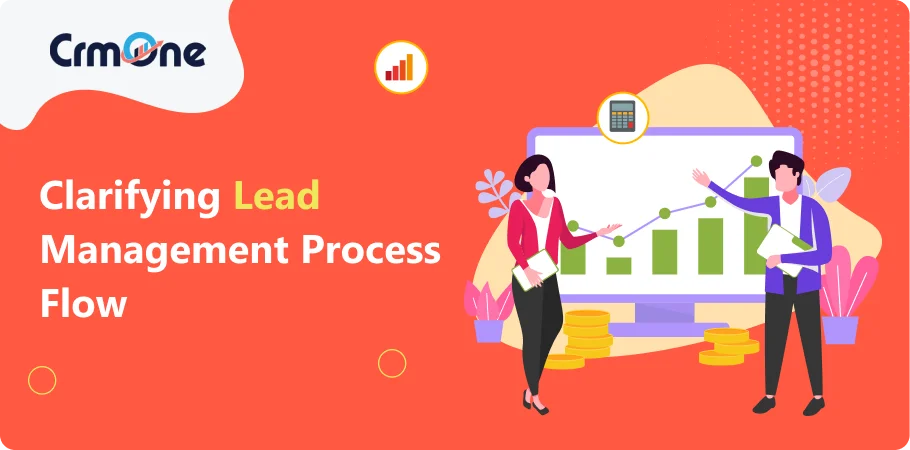In today’s fast-paced business landscape, where competition is fierce and customer expectations evolve rapidly, effective lead management has become indispensable for success. Companies across various sectors, from agile startups to multinational corporations, have recognized it as a cornerstone of their business strategies. The ability to attract, nurture, and convert leads into paying customers relies heavily on the seamless integration of efficient processes.
These include identifying potential customers, understanding their needs, and strategically moving them through the sales funnel. This guide will unravel the complexities of lead management, providing valuable insights into the process flow, strategic approaches, and best practices that can help businesses maximize their conversion rates and foster long-term relationships. Embracing these principles empowers businesses to build strong customer relationships while streamlining operations for a more efficient and profitable future.
In this guide, we’ll delve deep into the intricacies of lead management, exploring the process flow, strategies, and best practices to maximize results.
Understanding Lead Management process:
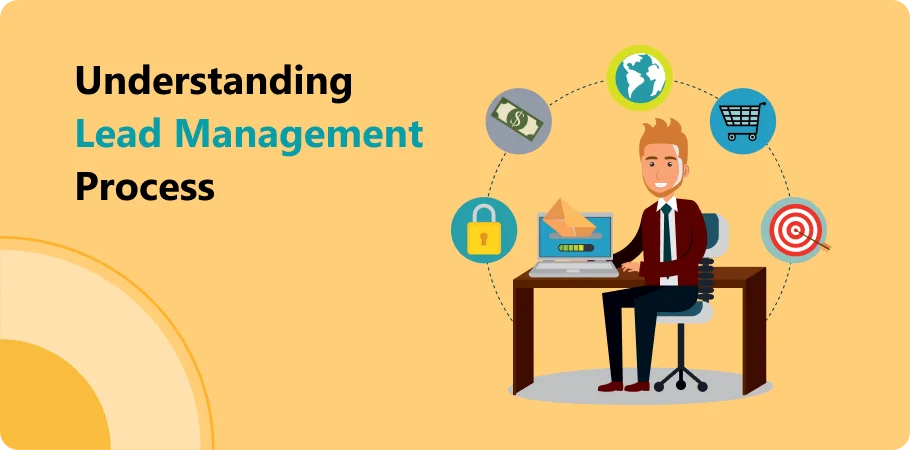
Lead management is a strategic, methodical approach to capturing, tracking, and nurturing potential customers, guiding them from their initial interaction to a final conversion. This process begins with lead generation, where prospects are identified and brought into the pipeline through various marketing channels. Next, leads are carefully qualified based on predefined criteria, ensuring that only those with the highest potential for conversion are pursued. Lead nurturing then focuses on building and maintaining relationships through personalized communication, guiding prospects through each stage of the sales funnel with relevant content and targeted outreach.
Finally, sales representatives close the deal by presenting tailored solutions that address the prospect’s unique needs and concerns. By optimizing every stage of this structured process, businesses can enhance their engagements, improve conversion rates, and maintain a streamlined approach to lead management that aligns with their overall growth objectives. Such a refined strategy ensures businesses efficiently allocate their resources, strengthening customer relationships while maximizing opportunities for revenue growth.
The Significance of Effective Lead Management process:
A robust and efficient lead management software plays a pivotal role in a business’s growth strategy. Firstly, it empowers organizations to channel their resources effectively toward high-quality leads that exhibit a strong likelihood of conversion. This strategic focus improves conversion prospects, optimizes ROI, and minimizes the waste of resources on leads that are unlikely to convert.
Moreover, by fostering closer collaboration between sales and marketing teams, it enables these traditionally separate functions to work cohesively toward shared objectives, ensuring that both departments are aligned in their approach to attracting, qualifying, and nurturing leads
This synergy not only enhances the overall effectiveness of lead management but also helps build a seamless transition from marketing to sales, providing a consistent customer experience. Furthermore, a well-implemented lead management system offers critical insights into customer behavior and preferences, enabling businesses to continuously refine and enhance their customer relationship management (CRM) strategies.
By understanding which leads are most engaged, what content resonates with them, and their specific pain points, businesses can tailor their engagement strategies to meet customer needs more effectively. Ultimately, this continuous improvement strengthens the customer journey, fostering loyalty and driving sustained growth through improved conversion rates and customer retention.
Lead Management Work Flow:
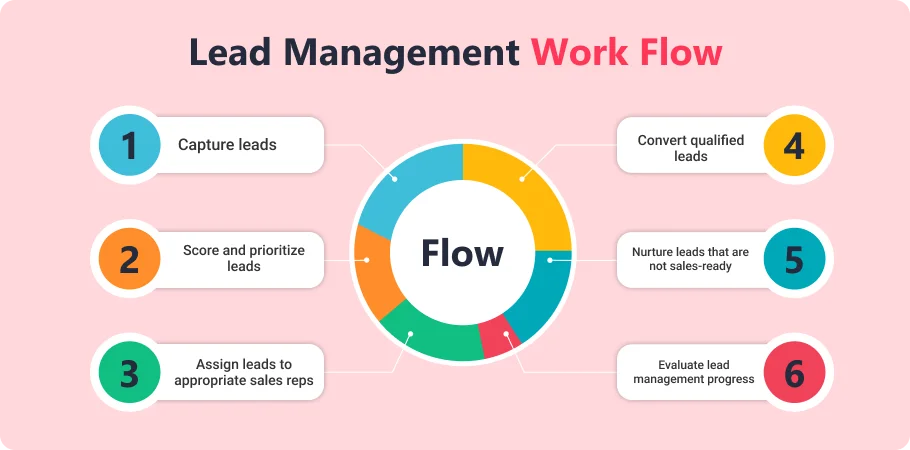
The lead management workflow is a well-defined series of steps that systematically guide a potential customer from their initial interest to becoming a paying client. Each stage serves a unique purpose in nurturing and converting leads, laying the groundwork for a seamless transition through the sales funnel. It starts with lead generation, which focuses on capturing new prospects through various channels, such as social media, content marketing, and advertising. The next step, lead capture, ensures that important information from interested prospects is collected through forms or landing pages, enabling future engagement.
Lead qualification follows, where businesses evaluate prospects based on predetermined criteria to determine their potential for conversion. Qualified leads are then scored and segmented according to their engagement, demographics, and behavior, prioritizing those with the highest likelihood of conversion. Lead nurturing becomes the focal point next, as businesses build personalized relationships through targeted content and communication to address the unique needs and concerns of each prospect.
Once sufficiently nurtured, sales outreach kicks in, where tailored offers and solutions are presented to prospects, meeting their specific challenges. This stage demands timely, personalized engagement to move leads closer to a purchase decision. Finally, the workflow culminates in lead conversion, where prospects are transformed into customers, closing the deal with a seamless purchasing process.
By carefully following this structured process, businesses can improve their understanding of the customer journey and streamline their engagement strategy. This clarity and structure ultimately enhance conversion rates, optimize resource allocation, and foster sustainable growth.
Lead Generation:
The lead management process kicks off with lead generation, where the focus lies on attracting new leads via a range of channels, including social media, content marketing, email campaigns, and advertising.
Once these potential customers show initial interest by downloading an ebook, subscribing to a newsletter, or requesting a demo, they enter the lead nurturing stage. Here, targeted communication keeps your brand top-of-mind, educates them about your offerings, and gently nudges them further down the sales funnel, making them sales-qualified leads.
This stage aims to capture the interest of potential customers, encouraging them to provide essential details, such as maybe their phone number, thus initiating the process of engagement and conversion.
Lead Capture:
Upon generating leads, it becomes imperative to capture them through lead capture forms, landing pages, or other channels. This pivotal step guarantees the collection of contact information for future engagement.
Effective lead capture goes beyond simply collecting names and emails. By strategically crafting lead capture forms with the right fields and offering valuable incentives in exchange for information, businesses can gather deeper insights into their audience’s needs and preferences. This enables them to personalize communication for better engagement and ultimately, higher lead conversion rates.
It sets the stage for nurture leads and facilitates their integration into lead management systems for organized tracking and follow-up.
Lead Qualification:
Lead qualification serves as the pivotal stage in discerning the potential of leads to convert into customers, guided by predefined criteria like demographics, behavior, and interest level. This process acknowledges that not all leads generated are of equal value. It segregates leads based on their likelihood of conversion, ensuring that resources are directed towards those with the highest potential.
Lead qualification complements efforts to generate leads and works hand in hand with customer relationship management (CRM) systems, providing insights that enhance targeted engagement and personalized interactions.
Lead Scoring process:
Lead scoring entails attributing a numerical score to different categories of leads depending on their probability of convert. This method considers factors such as engagement level, demographics, and behavior to prioritize leads for follow-up actions.
By assigning higher scores to leads who exhibit behaviors indicative of a strong fit, like visiting product pages or attending webinars, sales teams can prioritize their outreach. This ensures they dedicate their time to the most promising leads, maximizing their efficiency and accelerating the sales cycle.
Incorporating lead scoring into the lead process enables businesses to efficiently identify and focus on the most promising types of leads, optimizing their efforts for maximum conversion potential.
Lead Nurturing:
Lead nurturing involves developing relationships with interested prospects over time through targeted communication and personalized content. This step aims to keep promising leads engaged and moving through the sales funnel.
Effective lead nurturing utilizes a variety of content formats, such as educational blog posts, informative case studies, and free trials, to address prospects’ specific needs and pain points. By delivering valuable resources and demonstrating expertise, businesses build trust and position themselves as trusted advisors, ultimately influencing buying decisions.
Sales Outreach:
After attracting leads with a lead magnet, nurturing them becomes essential. Once leads are sufficiently nurtured, sales representatives reach out to them with tailored offers or solutions.
This personalized outreach, informed by the insights gleaned from lead scoring, allows salespeople to present relevant solutions that address the prospects’ specific pain points. By striking up conversations that prioritize value and problem-solving, sales reps can build trust and pave the way for a successful conversion.
This step demands timely and personalized communication to attend to the requirements and challenges faced by leads, thereby facilitating the conversion of more leads into customers.
Lead Conversion:
The ultimate aim of the lead management process is to convert leads into paying customers. This pivotal step involves closing the deal and facilitating the purchase process of the product or service.
In the realm of lead conversion, the primary objective is to seamlessly transition potential leads into loyal customers. This critical phase entails effectively closing the deal and streamlining the purchase journey for the product or service offered. It marks the culmination of efforts to nurture and engage leads, ensuring a successful conversion into paying customers.
It signifies the culmination of coordinated marketing and sales efforts, guiding potential customers towards the decision to invest in the product or service offered.
Post-Sales Engagement:
Even after conversion, sales teams continue to nurture the relationship with customers. Post-sales engagement is essential for delivering exceptional customer service, building loyalty, and encouraging repeat business.
Even after conversion, sales teams persist in nurturing customer relationships. Post-sales engagement is indispensable, ensuring outstanding customer service, fostering loyalty, and stimulating repeat business. Through ongoing interaction and support, companies reinforce their commitment to customer satisfaction, solidifying their position as trusted partners in the marketplace.
It is an integral part of the entire lead management process, ensuring that customers are satisfied and retained for long-term success.
Book a CrmOne Demo
Experience the CrmOne simplicity and power. Our experts will show you the best ways to use it and answer your questions in real time. See how CRMOne fits your needs.
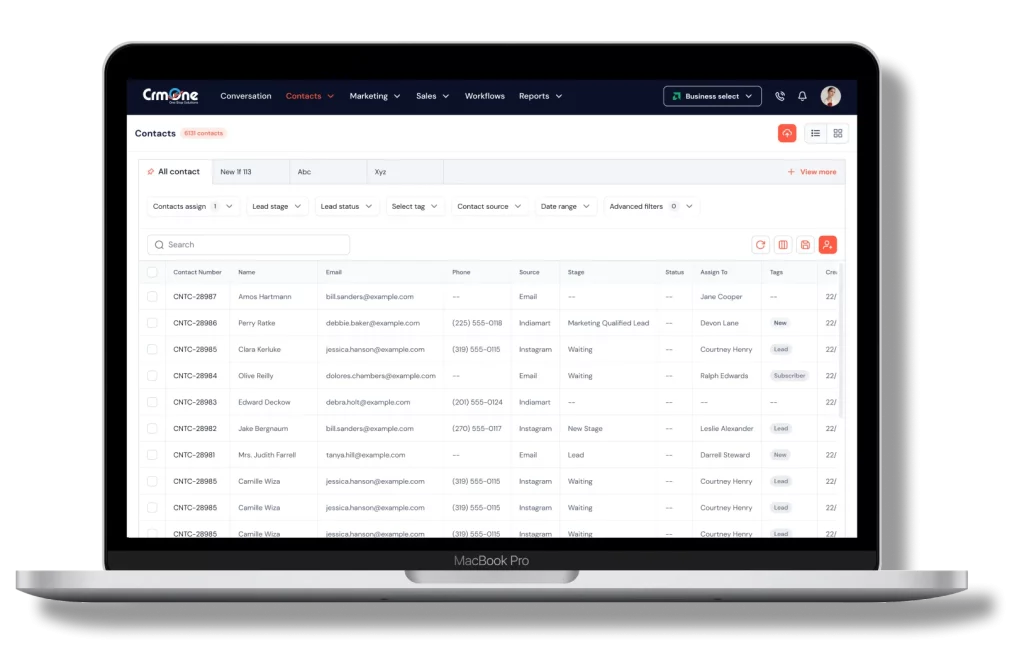
Strategies for Effective Lead Management process:
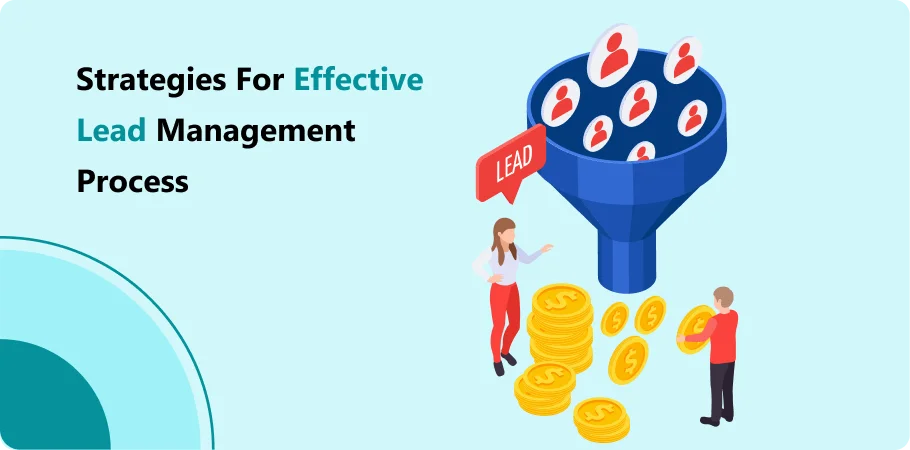
To optimize the lead management process, businesses can implement the following strategies:
Trading and Marketing Alignment:
Harmonizing trading and marketing teams ensures a cohesive approach to lead management. Clear communication and shared goals enhance collaboration, driving better results in navigating the lead qualification process.
Through cohesive alignment of trading and marketing teams, a unified front is formed in lead management. By fostering transparent communication and unified objectives, collaboration is bolstered, resulting in improved efficacy in navigating lead qualification. This synergy facilitates streamlined processes, ultimately yielding enhanced outcomes in lead conversion.
This alignment facilitates effective engagement with prospective customers, optimizing efforts for improved outcomes.
Lead Scoring and Segmentation:
By utilizing lead scoring and segmentation, businesses can prioritize leads and tailor their approach based on individual characteristics and behavior. This enables companies to pivot their resources on interacting with the target audience and identifying hot leads that are most likely to convert.
Lead scoring and segmentation are crucial tactics utilized utilized by marketing and sales teams to streamline lead management. Through lead scoring, leads are assigned numerical values based on their likelihood to convert, aiding teams in prioritizing their efforts on high-potential prospects.
Segmentation involves categorizing leads into distinct groups based on characteristics such as demographics, behavior, or interests. By employing these methods, sales and marketing teams can efficiently identify marketing qualified leads and tailor their strategies to engage with them effectively, ultimately improving conversion rates and maximizing ROI.
Automation and Integration:
Employing sales automation tool and integrating them with existing systems streamlines the lead management process, saving time and increasing efficiency. These tools assist in the identification and handling of qualified leads, enabling teams to prioritize their efforts effectively.
Utilizing sales automation tools and seamlessly integrating them with current systems optimizes lead management workflows, reducing time constraints and boosting productivity. These technological aids play a pivotal role in swiftly identifying and managing qualified leads, empowering teams to allocate their resources strategically. Consequently, this streamlined approach enhances overall efficiency and ensures a more targeted focus on high-potential prospects.
By leveraging automation, businesses can optimize their workflows and ensure that sales qualified lead are efficiently nurtured and guided through the sales pipeline, ultimately boosting conversion rates and driving growth.
Personalized Communication:
Tailored communication plays a pivotal role in enhancing the customer journey. By crafting personalized messages and content, businesses can effectively engage with their audience at various touchpoints throughout the customer journey. This personalized approach allows for deeper connections with customers, addressing their individual needs and preferences more effectively.
Customized communication is instrumental in elevating the customer experience journey. Through tailored messages and content, businesses forge meaningful connections with their audience across different stages of interaction. This personalized engagement enables a profound understanding of each customer’s unique requirements and desires, fostering stronger relationships and greater satisfaction.
Through personalized communication, businesses can build trust, loyalty, and satisfaction, ultimately enriching the overall customer journey and driving long-term success.
Continuous Optimization:
Regularly analyzing data and performance metrics allows sales team to identify areas for improvement and redefine their lead management strategies accordingly. This analytical approach enables teams to gain insights into their performance, identifying strengths and weaknesses in their processes.
Consistent data analysis empowers sales teams to refine lead management strategies by pinpointing areas ripe for enhancement. By delving into performance metrics, teams gain valuable insights into their effectiveness, discerning both strengths and weaknesses within their workflows. This analytical prowess not only guides strategic adjustments but also cultivates a culture of continuous improvement, driving sustained success in lead management endeavors.
By leveraging data-driven insights, sales team can refine their approaches, optimize resource allocation, and ultimately enhance their effectiveness in nurturing leads and driving conversions.
Effective Lead Management Process:
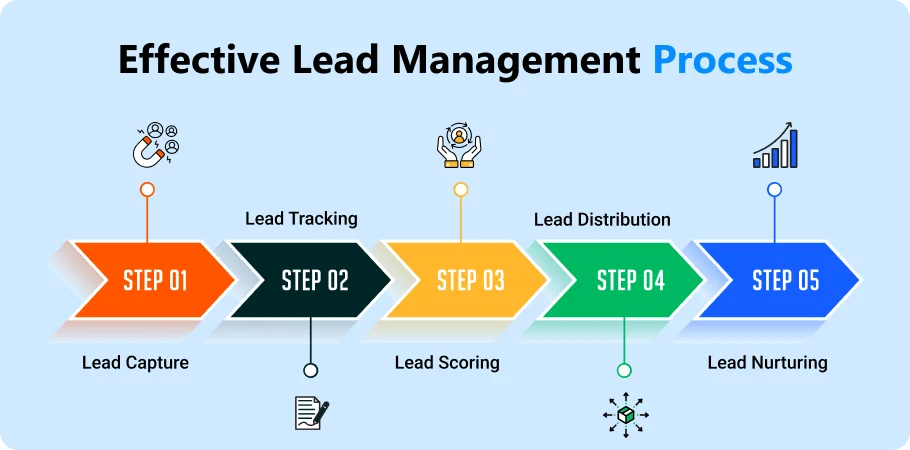
Implementing an productive lead management process is crucial for sustainable growth. By defining clear workflows, roles, and responsibilities, businesses can ensure consistency and accountability throughout the lead lifecycle.
Additionally, integrating advanced CRM systems can streamline lead tracking and communication, while analytics tools offer valuable insights into lead behavior and conversion patterns. Regular evaluation and refinement of the lead management process are essential for adapting to market changes and maximizing conversion rates.
Lead Tracking and Monitoring:
Tracking and monitoring lead activity allows businesses to identify opportunities and challenges in real-time. By leveraging modern analytics and reporting tools, businesses can achieve valuable insights into lead behavior and engagement.
Moreover, establishing key performance indicators (KPIs) enables businesses to measure the effectiveness of their lead management strategies and make data-driven decisions for continuous improvement. By fostering a culture of proactive analysis and adaptation, organizations can stay agile and competitive in dynamic markets, ultimately driving sustainable growth and success.
Lead Distribution:
Proper lead distribution ensures that leads are assigned to assign to the most suitable sales reps based on factors such as territory, expertise, and workload. This maximizes the chances of conversion and ensures efficient use of resources.
Automating lead distribution through intelligent algorithms further optimizes efficiency, reducing manual workload and minimizing the risk of leads slipping through the cracks. Moreover, fostering collaboration between sales and marketing teams fosters a unified approach, aligning efforts to effectively nurture leads from initial contact to successful conversion.
Lead Nurturing Campaigns:
Developing targeted lead nurturing campaigns helps keep leads engaged and moving through the sales funnel. By delivering proper content and offers at the right time, businesses can build trust and credibility with leads and increase the likelihood of conversion.
Utilizing personalized communication channels such as email, social media, and targeted advertising enables businesses to tailor messages to the specific needs and interests of each lead segment. Furthermore, implementing lead scoring methodologies allows for prioritization of high-quality leads, ensuring resources are allocated effectively for maximum impact and ROI.
Lead Qualification Criteria:
Establishing clear lead qualification criteria ensures that sales representative focus their efforts on leads with the highest potential for conversion. This minimizes time wasted on unqualified leads and maximizes the efficiency of the sales process.
Utilizing personalized communication channels, such as email marketing and social media interactions, allows businesses to tailor their messages to individual leads’ preferences and interests. Additionally, leveraging marketing automation tools enables timely follow-ups and ensures consistent engagement, nurturing leads towards making informed purchasing decisions. Regular analysis of campaign performance and feedback loops further refines strategies for greater effectiveness over time.
Sales Enablement Tools:
Equipping sales reps with appropriate tools and assets empowers them to effectively engage with leads and close deals. This may include CRM software, sales automation tools, and communication platforms that streamline the sales process and enhance productivity.
Furthermore, providing comprehensive training and ongoing support ensures that sales reps are proficient in utilizing these tools to their full potential. Regular feedback loops and performance evaluations help identify areas for improvement and refine sales strategies, ultimately driving higher conversion rates and revenue growth.
Conclusion
In conclusion, CrmOne is essential for companies aiming to succeed in today’s competitive business landscape. By implementing a structured process flow, leveraging effective strategies, and prioritizing collaboration and personalization, companies can maximize their potential for lead generation, nurturing, and conversion.
By continually adapting to market dynamics and customer preferences, businesses can stay ahead of the curve and maintain a sustainable pipeline of qualified leads. Embracing innovation and data-driven decision-making further strengthens the lead management ecosystem, enabling companies to achieve long-term success and growth in their respective industries.
With the ongoing evolution of technology and shifts in consumer behavior shifts, adapting and refining lead management practices will be crucial for sustained success.
Get started for Free
Start for free today. Boost your sales by clicking the Get Started button. With CRMOne, you can manage leads, sales, and customer service all in one place.
